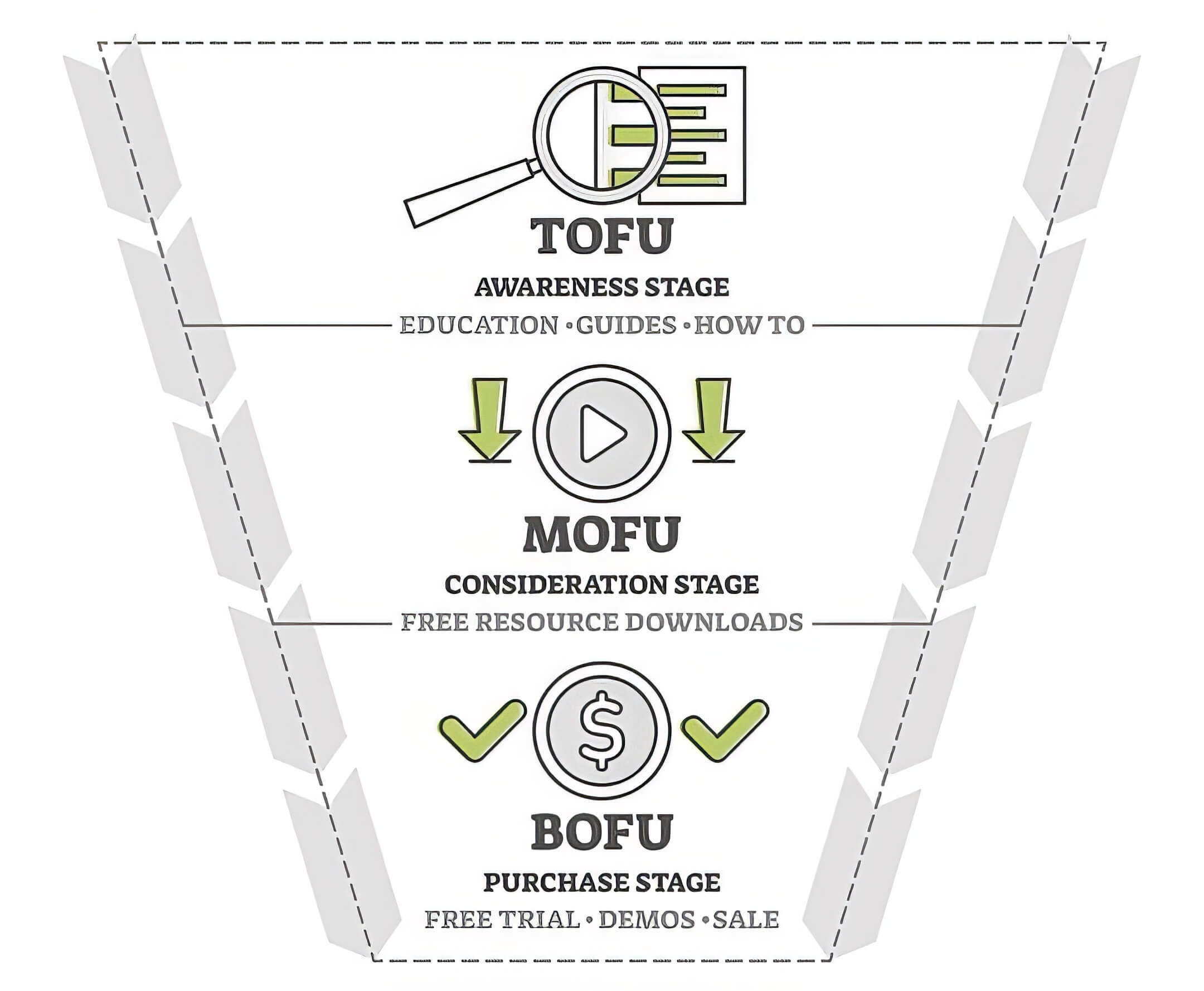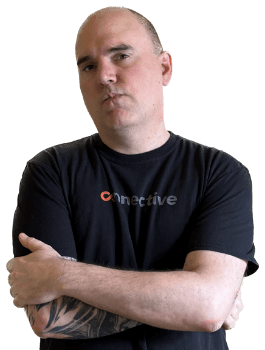If you struggle to get conversions despite having A+ search engine optimization (SEO) and a library of well-written content, you might need to rethink your content strategy to get back in the race.
One of the main goals of your content marketing strategy should be to lay the groundwork for an uninterrupted buyer’s journey, deftly moving prospective customers from awareness of your brand to buying your products or services.
A simple and effective way to visualize this process is the content marketing funnel, which portrays a customer’s progress from the top (awareness) to the bottom (purchase).
In this guide, I’ll explain what a content marketing funnel is and how you can use it to create a content strategy that helps your business grow. As the CEO of a digital marketing agency, I’ve helped many clients get more sales with the tips I’m about to share in this article!
What is a content marketing funnel?
As I briefly mentioned already, a content marketing funnel is a visual model you can use as a guide when developing your content marketing strategies. The funnel represents your prospect’s journey from their first interaction with your brand to when they become a paying customer.
The content you create for your site should align with the different stages of the funnel to help move potential customers from the top to the bottom.
Here are the three stages of the content marketing funnel:
- Top of the funnel (TOFU): The first stage is primarily for creating awareness of your brand and products by providing value through informational content.
- Middle of the funnel (MOFU): The middle of the funnel focuses on cultivating interest in your brand and generating leads through a deeper level of content.
- Bottom of the funnel (BOFU): The final stage is when the customer is ready to make a purchase, and you must convince them to choose your brand with persuasive content.

Try to figure out the best type of content to fulfill the goals of each stage of the funnel while satisfying the target audience’s needs. Your content should, of course, relate to your brand, including any products and services under its banner.
However, depending on the buyer’s stage the content pertains to, the topic and tone of the content will vary from general information to specific, sales-focused subjects. Knowing the differences between funnel stages and populating each with the most appropriate content is key.
Mapping out content along the marketing funnel helps identify gaps in your content strategy that could hinder the buyer’s journey.
For example, you might have plenty of pieces that introduce prospective customers to your brand but lack enough MOFU content to get users to engage more with the products it offers.
Let’s take a look at the different stages of the content marketing funnel so you can get an idea of which types of content, goals, and metrics are suitable for each level:
Top of the funnel (TOFU)
TOFU (not the squishy edible kind) is the starting line for your potential customers. At this stage, they’re looking for answers to their questions, but they’re not ready to buy anything. They might have never heard of your brand at this point.
Your goals for TOFU content should be to attract attention, provide helpful information, and subtly introduce your brand. Your TOFU content will consist of educational pieces that provide users with some type of value that draws them to your site.
The best types of content for TOFU include the following:
- How-to guides
- Checklists
- Infographics
- E-books
Whether you’re making simple guides, comprehensive e-books, or even writing blog posts, TOFU content helps customers solve problems and shows that you’re an expert on the topic.
Customers typically find TOFU pieces through organic search, but they could also discover them through social media or email marketing.
You can measure the success of your content strategy at the TOFU stage by looking at metrics like organic traffic, social media engagement, and website engagement. You want to ensure you’re attracting attention and maintaining it long enough to get prospects interested in your brand.
Middle of the funnel (MOFU)
You’ll notice fewer people interact with your MOFU content, but these users are more likely to engage further with your brand and its products or services. Your job is to leverage interest and encourage potential customers to think about making a purchase.
As we move down the funnel, the content is less introductory, focusing instead on giving customers a deeper understanding of the topic so they can get closer to solving their problems.
At the MOFU level, your content should focus more on your brand’s products and how they can solve the prospect’s issue. The content you create for this stage could include the following:
- Guides
- Product overviews
- Case studies
- Landing pages
- Webinars
A case study is a great example of a MOFU content piece because it shows how your product positively impacts other customers. Prospects will see the benefits of your product or service, and the excitement of finding a potential solution to their problem can lead them to move further down the funnel.
To track your MOFU content strategy, look at metrics like conversion rates, number of leads, and time spent on the page. It’s best to create a variety of MOFU pieces highlighting different benefits and uses to help capture more leads.
While prospects can find MOFU content through organic search, email marketing is one of the best ways to nurture your leads at this stage.
Bottom of the funnel (BOFU)
The customer’s finish line is at the bottom of the funnel, and your content for BOFU is all about getting your prospects to cross that line and make a purchase. You should create content that builds trust and shows how your brand is better than the competition.
Customers engaging with BOFU content are generally ready to buy, but they’re still deciding which product or service would be the most worthwhile investment.
Your goal, therefore, should be to persuade them that your brand is the best choice. You can do this by answering questions about your products, including how they work and the problems they solve.
BOFU content usually falls into these categories:
- Product overviews
- Success stories
- Customer reviews
- Case studies
As you may know, most customers make buying decisions based on reviews. Therefore, customer-created content, like customer reviews or testimonials, is going to be the most effective type of BOFU content for getting conversions.
To find out how your BOFU content strategy is working, look at the number of demo and free trial requests, revenue, number of conversions, and content marketing return on investment (ROI).
How to start building your content marketing funnel

Okay, now you know all about the content marketing funnel, including what the three stages are and which types of content go with each. You are ready to start reviewing your current content strategy and each piece of content you’ve created.
It helps to sort your existing content into the stages of the buyer’s journey, giving you a clear picture of your content marketing funnel. Doing this could indicate the need for more educational TOFU content or that you don’t have BOFU content for certain products.
In other words, it gives you a map to follow when creating your content strategy.
One of the most crucial steps to take before going any further is ensuring you understand your company’s objectives and how the most viable content strategy will address them.
Depending on the growth stage of your business, whether it’s a startup or a large corporation, your content marketing needs will vary. While a startup would probably be better off expanding its lead-generating MOFU pieces, corporations are likely more concerned with generating lots of traffic with TOFU content.
Before developing your content strategy according to the marketing funnel, be sure to do the following:
- Understand your target audience’s issues and goals
- Map out your target audience’s buyer’s journey
- Establish your content marketing goals
- Conduct a competitor analysis
Analyzing your competitors’ content strategies reveals content gaps they haven’t addressed, allowing you to meet target audience needs before they do.
Tips on creating content for each stage of the marketing funnel

A suitable content strategy helps you lay out the necessary content to meet your business goals. You’ll organize your content by which stage of the content marketing funnel it aligns with, starting with creating awareness and ending with a purchasing decision.
Once you know what content you need to make, you can create a content calendar, prioritizing which pieces to create first. It’s essential to keep track of your content calendar to see what’s in your queue and where each piece falls in the funnel.
You might need to adjust your priorities as you go, referring to the various metrics and KPIs to see which stages of the customer journey require more attention.
Here are some tips for creating effective content for each stage of the marketing funnel:
Educate and intrigue prospects with TOFU content
Solving problems for potential customers is one of the easiest and most effective ways to attract attention to your brand. You can provide valuable educational content to your prospects for free, cultivating trust and positioning yourself as an authority on the subject.
Be sure to follow these guidelines in your TOFU content:
- Be honest and authentic
- Focus on the audience’s problem
- Answer questions related to the issue
- Provide solutions
- Briefly mention your products or services
- Add related sources
Don’t be too sales-y in TOFU content. Instead, focus on addressing the issue and providing valuable information, sprinkling in mentions of your brand or product.
You’re essentially planting the seed of interest in your readers, hopefully leading them to check out your brand rather than others as they become more familiar with it.
Draw in potential customers with MOFU content
You’ve gained some intrigue in the middle of the funnel, and it’s time to keep pulling your prospects in. You can accomplish this by providing users with free resources that help them address the issues they’re trying to solve, which makes your brand valuable to them.
Your MOFU content will mostly showcase how your products or services are better than those of your competitors. You should emphasize how your product makes the prospective customer’s life easier or better.
A quintessential example of MOFU content is an e-book providing useful data your prospects can use to answer their questions. The resource shows your brand’s expertise (a key part of Google’s EEAT system) and value to customers, encouraging them to keep moving down the funnel.
Convert prospects into paying customers with BOFU content
You got the attention of your prospects and showed them what you have to offer, so now you have a small pool of highly interested leads. They’re well on their way to making a purchase, and your goal is to convince them to choose your brand over the competition.
Considering the most trustworthy resources for consumers are customer reviews and first-hand experiences, your BOFU content should target your audience with strategies like:
- Free trials
- Product comparisons
- Product demos
- Client testimonials
- Consultations
Your BOFU content is where you can brag about how awesome your product is, using demos and webinars to show off its benefits to potential customers.
One example of nurturing leads with BOFU content is sending an email with a link to sign up for a seven-day free trial after they attend a webinar.
Conclusion

You can come up with a content strategy in a million different ways, but the key is discovering what works best for you and your target audience. You’ll need a deep understanding of your prospects, including their needs, what they’re searching for, and how best to solve their problems.
Knowing these things will help keep your audience in mind — and you in theirs — with each blog post, landing page, or e-book you create.
You’ll go through plenty of trial and error figuring out the best content strategy, but all these content marketing efforts will pay off as you gain and convert more leads for your business.









